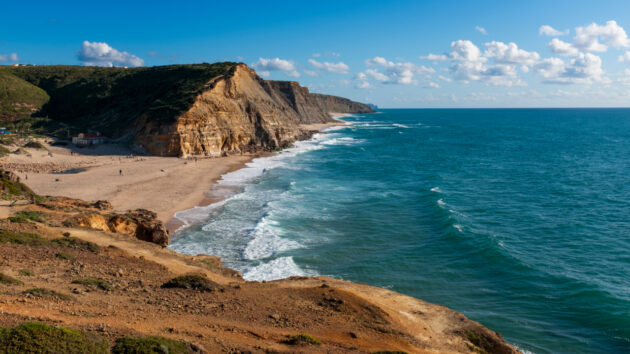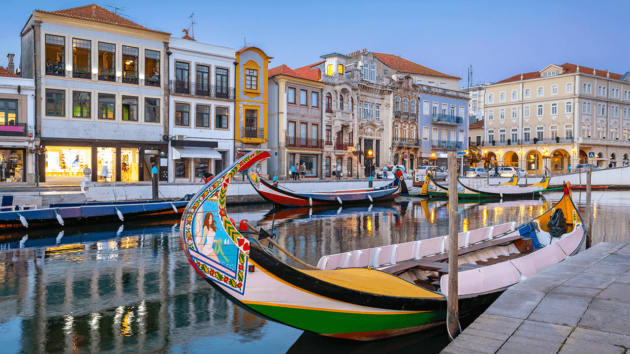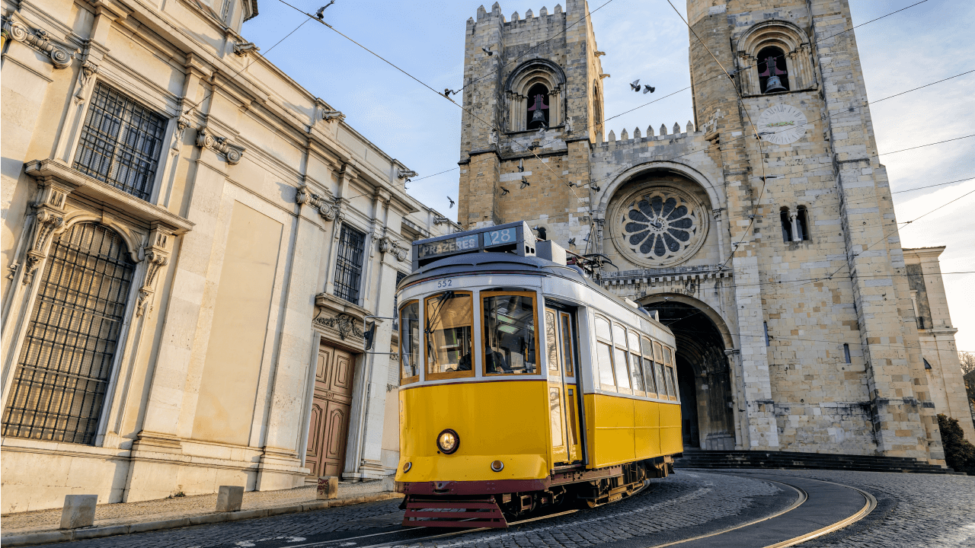
Over one century after having begun to operate in the Portuguese capital, we can gaze upon the traditional trams of Lisbon and marvel at how far ahead of their time they were. Here we have a charming and non-polluting form of collective transport.
Now, as electric vehicles are all the rage, these yellow classics continue to make their rounds of the city, carrying up to 42 passengers as they slide along the network of rails with the aid of a pulley. Come with us on a discovery of the city of seven hills, on picture perfect rides that just get better with age.
The famous 28
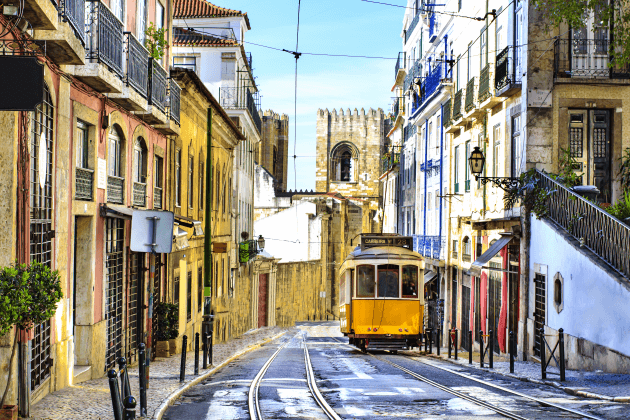
The route taken by the 28 tram is estimated at 48 minutes, carrying you up, down, and through historical neighbourhoods such as the Graça, Alfama, Chiado, and Campo de Ourique. An adventure through the heart of Lisbon.
Instead of the number 28, this tram, which begins its route in the Martim Moniz Square and finishes near Lisbon’s most emblematic cemetery, in Prazeres, could very well bear the name “desire”, just like in Elia Kazan’s famous film.
This is Lisbon’s most popular of trams and you can sometimes be difficult to board, given the amount of interest it generates amongst tourists, attracted by the fact that it crosses such typical neighbourhoods, the sinuous streets it rides along, and the steep climbs and descents. Even though it is a unique tourist attraction, however, 28 continues to be used by locals during their daily travels.
Your trip will begin in the Martim Moniz Square, in the parish of Socorro, on the outskirts of Downtown Lisbon. Note that crowds to board the trams can get quite big, so an alternative is to start at the other end, in the Prazeres, and do the route in the opposite direction.
As you climb the metal steps of this Lisbon tram you will be transported into another world. The conductor, the leather seats, the “beware of pickpockets” warnings and other varnished wood details make this experience akin to time-travel.
Following along the Rua da Palma, towards Anjos, along the longest avenue in Lisbon, Almirante Reis, the 28 prepares to climb one of Lisbon’s largest hills, Graça. Next comes one of the most entertaining parts of the trip, the jittery descent down through Alfama.
You’d think that the tram wants to crash through the houses, in a rage, as it seems to scrape their walls. Tourist’s hearts skip a beat when they see children and more foolhardy types cling to the back of the carriage for free rides.
The streets finally widen as the tram draws near the Cathedral, and one’s eyes are drawn to all the minute details. As it enters the Chiado it sails past the Faculty of Fine Arts, goes around the Camões Square (beneath the Bairro Alto), and gets within earshot of the Santa Catarina birds before careening down the Calçada do Combro, one of the steepest streets in the historical centre.
This leads to São Bento, the neighbourhood which hosts the Parliament Building, before ascending once more towards the Estrela, with its basilica on the left and the majestic garden on the right. The last neighbourhood you will be taken through is Campo de Ourique before the tram finally grinds to a halt at the gates of the Prazeres Cemetery, where some of Portugal’s most famous figures, such as poet Mário Cesariny, painter José Malhoa or author José Cardoso Pires found their final resting places.
Although the full course of the 28 connects the Martim Moniz to Campo de Ourique (Prazeres), the quantity of tourists seeking this attraction led to the provision of trams that run a shortened route, from the Graça to the Estrela.
12, the swift
The number 12 has the shortest route of all the Lisbon trams, running in a circle that begins in the Martim Moniz and reaches the Castle.
That’s merely a 21 minute journey, with 11 stops, but the 12 tram has the benefit of carrying you up the highest hill in the city, to the Saint Jorge Castle, making it a noteworthy mode of transport.
The old number 12 tram stops at some of the same points as the 28. They both begin in Praça Martim Moniz and make stops at the Portas do Sol Square or the Santa Luzia Belvedere, one of Lisbon’s finest, which commands a view over the tiled rooftops and buildings which are reflected on the surface of the Tagus River.
After reaching the gates of the Saint Jorge Castle (Limoeiro), the tram descends past the Cathedral, then follows Rua dos Fanqueiros, in the Downtown, before heading back to its starting point.
15, the riverside tram
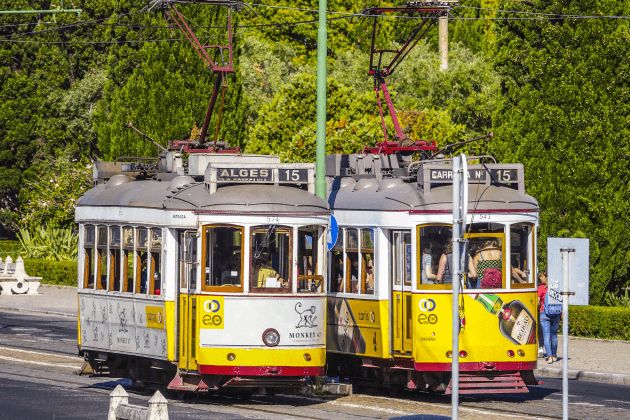
Many of the number 15 trams are modern and articulated, but occasionally an older model surprises those who wait to travel along the riverside.
You will need some luck to catch one of these older trams on this route that goes from the Praça da Figueira to Algés. Most of the number 15 trams are modern, made in the 90s, and aimed more at efficiency and speed than historical charm. Regardless, it is worth taking the trip along the number 15 route, as it is the only one in the city that will take you along the riverside.
Beginning in the Praça da Figueira, which used to be one of the major markets for horticultural products grown on the outskirts of the city, and which still hosts the odd fair and market, the number 15 tram begins by giving its passengers a view over one of Lisbon’s crown jewels, the Praça do Comércio, with its arcades and its enormous open square, constantly bustling with people.
A five-minute stretch gets you to the Cais do Sodré, which has historically been (and remains) a popular spot for bars, nightlife, and music. Years ago, this is where sailors would come to drown their sorrows, have some fun, and get some rest in the local inns. Today the area is dominated by clubs and leisure haunts such as Music Box or the Pensão Amor.
If you stay onboard, you will find yourself travelling parallel to the river, towards Alcântara, where the Carris Museum (the company that runs the Lisbon trams) is located. Here you can take a trip through the history of public transport in Lisbon, through photographs, uniforms, tram tickets, trams, and old buses, since the days when the carriages were drawn by animals (Carris has existed since 1872).
But the highlight of the route is yet to come. Many tourists feel compelled to exit the tram in Belém, one of Lisbon’s most monumental and symbolic spots, closely connected to the discoveries. The Jerónimos Monastery and the Belém Tower are intimately linked to the country’s history, and indispensable for any visitor.
But even if your taste is more contemporary, there is still much to see, such as the Belém Cultural Centre (which includes the Berardo Collection Museum) and the MAAT – Museum of Art, Architecture, and Technology which promise to delight art lovers.
The number 18 tram also runs along the riverside for a spell. However, in Alcântara it diverts up towards the Ajuda Palace.
24, the Príncipe Real tram
Many locals use the number 24 tram for purely practical reasons, as it connects the city’s nerve centre to the business district. However, the 24 is the only tram in Lisbon that will take you to the lovely Príncipe Real area.
Its route begins in the Largo de Camões (a classical meeting point for those who go for walks in the Chiado or for dinner in the Bica or the Bairro Alto) and takes around 29 minutes to reach Campolide. It presents an opportunity to get to know some emblematic spots such as the São Pedro de Alcântara Belvedere, which overlooks the city, or the Príncipe Real, with its palaces, bistros, and shops, sporting the latest fashions.
Named after the Royal Prince who would become D. Pedro V, this district hosts one of the most beautiful gardens in the city where a 140-year-old gigantic cypress tree gently waves its branches to greet visitors. In the XIX Century, the Príncipe Real began to host markets and fairs, a practice which remains today, with the biological produce market and the handicraft fair.
The garden is surrounded by palaces that once kept Lisbon abuzz with their reveler-filled halls in the days when the nobility competed for best party. Keep an eye out for numbers 21 and 23 (Anjos Palace) and 26 (Ribeiro da Cunha Palace).
The tram continues its route past the Rua da Escola Politécnica – which was often crossed by famous author Eça de Queirós, on his way to the Confeitaria Cister – the Botanical Garden, and the National Museum of Natural History and Science. Before you arrive at your destination, in Campolide, you can admire the controversial Amoreiras complex, designed by Tomás Taveira, which was the first large modern shopping centre in Portugal.
25, the Lapa tram
The Lapa neighbourhood, with its mansions overlooking the river, many of which are now embassies, would not be the same without the number 25 tram. The journey begins in the Praça da Figueira and ends in Campo de Ourique.
The 25 starts rolling in the central Baixa district, heads along the Rua de São Paulo and the Conde Barão and keeps its distance from the Tagus until it reaches Santos. That is where it starts climbing up to Santos-o-Velho, a charming sector which is home to the Madragoa neighbourhood and one of the country’s most unique and beautiful museums, the National Museum of Classical Art.
From Santos-o-Velho it is just a couple of minutes to the Lapa, a hilltop and glamorous neighborhood, bathed in light. The Lapa is home to several embassies, with their magnificent private gardens, the charm of which can be guessed at from the visible treetops.
This is also where you can find one of the most typical Fado houses in Lisbon, Sr. Vinho, where you can taste traditional Portuguese cuisine and listen to performances by the likes of Aldina Duarte or Gisela João.
After leaving the Lapa this tram heads to the Estrela and stops right in front of the Basilica before going on its final stretch towards Campo de Ourique, making stops in front of the grandiose Santo Condestável Church and the Prazeres Cemitery.
The elevators
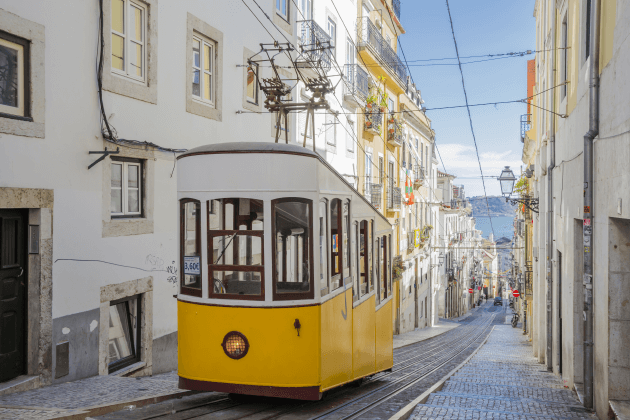
Although they are visually very similar to the trams, the Glória, Lavra, and Bica elevators play a different role, helping people get up and down some of Lisbon’s steepest hills.
On average, an elevator ride takes just over three minutes. The longest is the Bica which takes five minutes to climb from the Rua de São Paulo to the Calhariz. But that must be compared with the time it would take you to trek up the famous and photogenic Rua da Bica de Duarte Belo road by foot. That was the original purpose of the Lisbon elevators, to give you that little push when your legs began to buckle.
Besides the Bica Elevator, there are other heady climbing experiences to be had in Lisbon, namely the Glória Elevator, which connects the Restauradores, at the foot of the Avenida da Liberdade, to the São Pedro de Alcântara Belvedere, next to the Bairro Alto; and the Lavra Elevator, which runs between the Largo da Anunciada, behind the Avenida da Liberdade, and the Rua Câmara Pestana. From this point you can head out on foot to discover the two beautiful gardens of Campo dos Mártires da Pátria (a unique spot, complete with roaming chickens) and the lovely and almost hidden Jardim do Torel.
